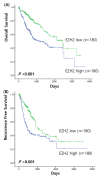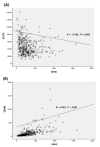Clinical Value of EZH2 in Hepatocellular Carcinoma and Its Potential for Target Therapy
- PMID: 35208478
- PMCID: PMC8877936
- DOI: 10.3390/medicina58020155
Clinical Value of EZH2 in Hepatocellular Carcinoma and Its Potential for Target Therapy
Abstract
Background and objectives: EZH2 is overexpressed in hepatocellular carcinoma (HCC) and is correlated with poor prognosis. However, its clinical significance and molecular mechanism have not been studied in HCC. In this study, clinical and prognostic values of EZH2 was studied using Total Cancer Genome Atlas (TCGA) data and then, these data were confirmed in Huh1 and HepG2 cell lines. Materials and Methods: We used the TCGA database from cBioPortal. In addition, we analyzed EZH2 mRNA levels in HCC cell lines and its correlation with STAT3 and EZH2. Results: According to TCGA, EZH2 had a prognostic value in various cancers, especially in HCC. Furthermore, EZH2 in HCC was correlated with N stage (p = 0.045) and alpha-fetoprotein (AFP) > 20 ng/mL (p < 0.01). However, a negative association between EZH2 and age (p = 0.027) was found. The overall survival result of HCC was significantly poorer in patients with high EZH2 expression. In addition, the recurrence rate was also significantly higher in patients with high expression of EZH2 than those with low expression (χ2 = 16.10, p < 0.001). EZH2 expression was negatively correlated with STAT3 expression among EZH2-associated genes (R = -0.163, p = 0.002). EZH2 expression level was down-regulated to 50% or less compared to the control group treated negative siRNA. MTT assays showed that EZH2-siRNA affected on the viability of HCC cell line significantly. Conclusions: In conclusion, the overexpression of EZH2 was an independent biomarker for poor outcomes of HCC. However, more in vivo studies are required to identify the downstream target genes in HCC to improve our understanding of the biological role of EZH2 in HCC.
Keywords: EZH2; STAT3; TCGA; hepatocellular carcinoma.
Conflict of interest statement
The authors declare no conflict of interest.
Figures





Similar articles
-
Long noncoding RNA UPK1A-AS1 indicates poor prognosis of hepatocellular carcinoma and promotes cell proliferation through interaction with EZH2.J Exp Clin Cancer Res. 2020 Oct 29;39(1):229. doi: 10.1186/s13046-020-01748-y. J Exp Clin Cancer Res. 2020. PMID: 33121524 Free PMC article.
-
EZH2 is a negative prognostic biomarker associated with immunosuppression in hepatocellular carcinoma.PLoS One. 2020 Nov 12;15(11):e0242191. doi: 10.1371/journal.pone.0242191. eCollection 2020. PLoS One. 2020. PMID: 33180829 Free PMC article.
-
MicroRNA-101 inhibits human hepatocellular carcinoma progression through EZH2 downregulation and increased cytostatic drug sensitivity.J Hepatol. 2014 Mar;60(3):590-8. doi: 10.1016/j.jhep.2013.10.028. Epub 2013 Nov 6. J Hepatol. 2014. PMID: 24211739
-
CLDN14 is epigenetically silenced by EZH2-mediated H3K27ME3 and is a novel prognostic biomarker in hepatocellular carcinoma.Carcinogenesis. 2016 Jun;37(6):557-566. doi: 10.1093/carcin/bgw036. Epub 2016 Mar 31. Carcinogenesis. 2016. PMID: 27207647
-
EZH2 in hepatocellular carcinoma: progression, immunity, and potential targeting therapies.Exp Hematol Oncol. 2023 Jun 2;12(1):52. doi: 10.1186/s40164-023-00405-2. Exp Hematol Oncol. 2023. PMID: 37268997 Free PMC article. Review.
Cited by
-
Comprehensive systems biology analysis of microRNA-101-3p regulatory network identifies crucial genes and pathways in hepatocellular carcinoma.J Genet Eng Biotechnol. 2025 Mar;23(1):100471. doi: 10.1016/j.jgeb.2025.100471. Epub 2025 Feb 18. J Genet Eng Biotechnol. 2025. PMID: 40074445 Free PMC article.
-
Integration of epigenomic and transcriptomic profiling uncovers EZH2 target genes linked to cysteine metabolism in hepatocellular carcinoma.Cell Death Dis. 2024 Nov 8;15(11):801. doi: 10.1038/s41419-024-07198-0. Cell Death Dis. 2024. PMID: 39516467 Free PMC article.
-
LINC00161 upregulated by M2-like tumor-associated macrophages promotes hepatocellular carcinoma progression by methylating HACE1 promoters.Cytotechnology. 2024 Dec;76(6):777-793. doi: 10.1007/s10616-024-00653-y. Epub 2024 Aug 16. Cytotechnology. 2024. PMID: 39435425
-
Key oncogenes and candidate drugs for hepatitis-B-driven hepatocellular carcinoma progression.Discov Oncol. 2025 Feb 4;16(1):116. doi: 10.1007/s12672-025-01851-6. Discov Oncol. 2025. PMID: 39903352 Free PMC article.
-
High Expression of EZH2 Mediated by ncRNAs Correlates with Poor Prognosis and Tumor Immune Infiltration of Hepatocellular Carcinoma.Genes (Basel). 2022 May 13;13(5):876. doi: 10.3390/genes13050876. Genes (Basel). 2022. PMID: 35627262 Free PMC article.
References
MeSH terms
Substances
Grants and funding
LinkOut - more resources
Full Text Sources
Medical
Miscellaneous

